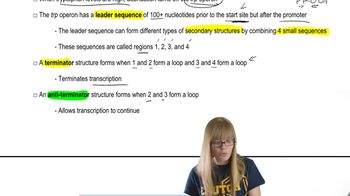Identify similarities and differences between an inducible operon and a repressible operon in terms of
the presence and action of allosteric regulatory molecules.
 Sanders 3rd Edition
Sanders 3rd Edition Ch. 12 - Regulation of Gene Expression in Bacteria and Bacteriophage
Ch. 12 - Regulation of Gene Expression in Bacteria and Bacteriophage Problem 6
Problem 6Is attenuation the product of an allosteric effect? Is attenuation the result of a transcriptional or a translational activity? Explain your answers.
 Verified step by step guidance
Verified step by step guidance
Verified Solution
Key Concepts
Attenuation

Allosteric Effect

Transcriptional vs. Translational Regulation

Identify similarities and differences between an inducible operon and a repressible operon in terms of
the organization of structural genes of the operon.
The transcription of -galactosidase and permease is inducible in lac⁺ bacteria with a wild-type lac operon. Explain the mechanism by which lactose gains access to the cell to induce transcription of the genes.
The trpL region contains four repeated DNA sequences that lead to the formation of stem-loop structures in mRNA. What are these stem-loop structures, and how do they affect transcription of the structural genes of the trp operon?
The CAP binding site in the lac promoter is the location of positive regulation of gene expression for the operon. Identify what binds at this site to produce positive regulation, under what circumstances binding occurs, and how binding exerts a positive effect.
What role does cAMP play in transcription of lac operon genes? What role does CAP play in transcription of lac operon genes?